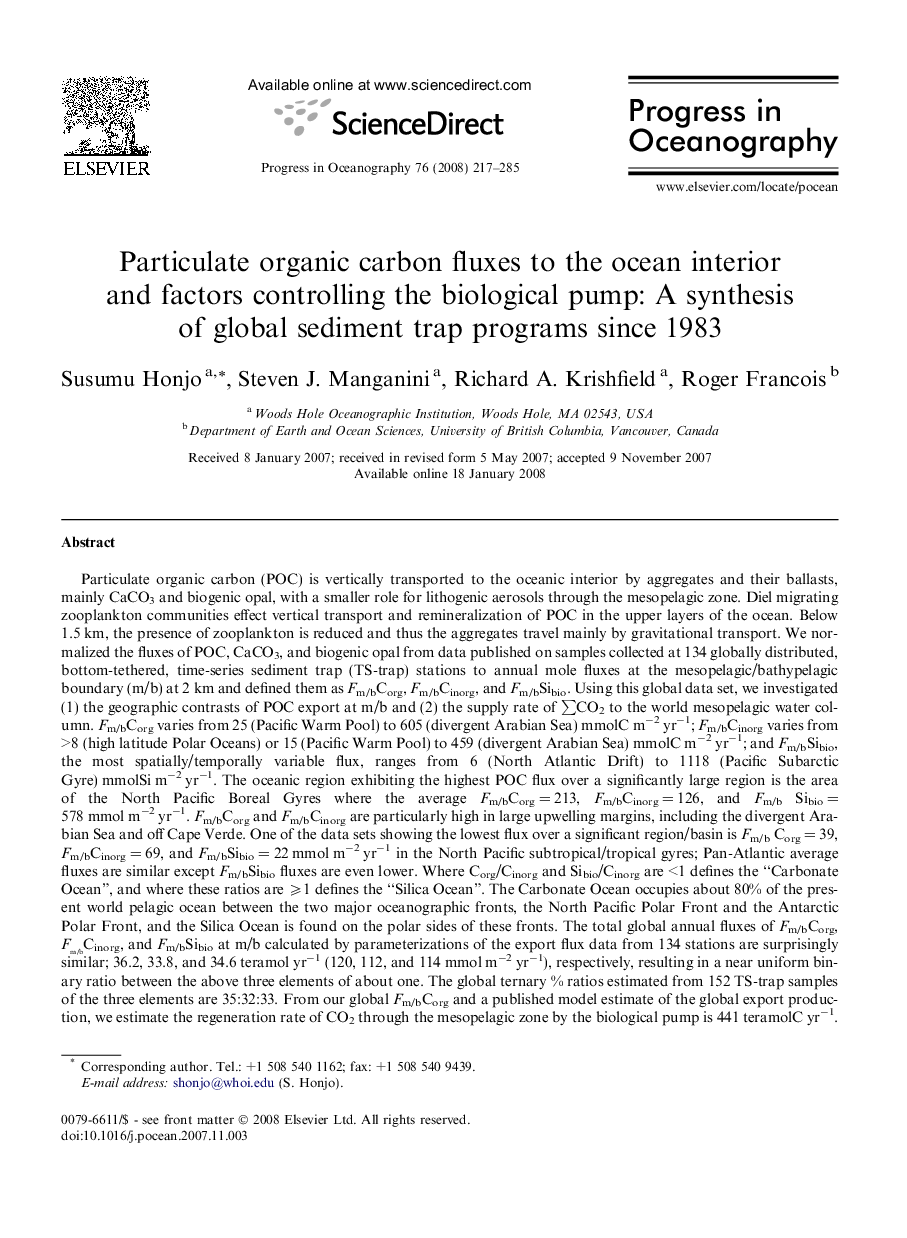| Article ID | Journal | Published Year | Pages | File Type |
|---|---|---|---|---|
| 4553808 | Progress in Oceanography | 2008 | 69 Pages |
Particulate organic carbon (POC) is vertically transported to the oceanic interior by aggregates and their ballasts, mainly CaCO3 and biogenic opal, with a smaller role for lithogenic aerosols through the mesopelagic zone. Diel migrating zooplankton communities effect vertical transport and remineralization of POC in the upper layers of the ocean. Below 1.5 km, the presence of zooplankton is reduced and thus the aggregates travel mainly by gravitational transport. We normalized the fluxes of POC, CaCO3, and biogenic opal from data published on samples collected at 134 globally distributed, bottom-tethered, time-series sediment trap (TS-trap) stations to annual mole fluxes at the mesopelagic/bathypelagic boundary (m/b) at 2 km and defined them as Fm/bCorg, Fm/bCinorg, and Fm/bSibio. Using this global data set, we investigated (1) the geographic contrasts of POC export at m/b and (2) the supply rate of ∑CO2 to the world mesopelagic water column. Fm/bCorg varies from 25 (Pacific Warm Pool) to 605 (divergent Arabian Sea) mmolC m−2 yr−1; Fm/bCinorg varies from >8 (high latitude Polar Oceans) or 15 (Pacific Warm Pool) to 459 (divergent Arabian Sea) mmolC m−2 yr−1; and Fm/bSibio, the most spatially/temporally variable flux, ranges from 6 (North Atlantic Drift) to 1118 (Pacific Subarctic Gyre) mmolSi m−2 yr−1. The oceanic region exhibiting the highest POC flux over a significantly large region is the area of the North Pacific Boreal Gyres where the average Fm/bCorg = 213, Fm/bCinorg = 126, and Fm/bSibio = 578 mmol m−2 yr−1. Fm/bCorg and Fm/bCinorg are particularly high in large upwelling margins, including the divergent Arabian Sea and off Cape Verde. One of the data sets showing the lowest flux over a significant region/basin is Fm/bCorg = 39, Fm/bCinorg = 69, and Fm/bSibio = 22 mmol m−2 yr−1 in the North Pacific subtropical/tropical gyres; Pan-Atlantic average fluxes are similar except Fm/bSibio fluxes are even lower. Where Corg/Cinorg and Sibio/Cinorg are <1 defines the “Carbonate Ocean”, and where these ratios are ⩾1 defines the “Silica Ocean”. The Carbonate Ocean occupies about 80% of the present world pelagic ocean between the two major oceanographic fronts, the North Pacific Polar Front and the Antarctic Polar Front, and the Silica Ocean is found on the polar sides of these fronts. The total global annual fluxes of Fm/bCorg, Fm/bCinorg, and Fm/bSibio at m/b calculated by parameterizations of the export flux data from 134 stations are surprisingly similar; 36.2, 33.8, and 34.6 teramol yr−1 (120, 112, and 114 mmol m−2 yr−1), respectively, resulting in a near uniform binary ratio between the above three elements of about one. The global ternary % ratios estimated from 152 TS-trap samples of the three elements are 35:32:33. From our global Fm/bCorg and a published model estimate of the global export production, we estimate the regeneration rate of CO2 through the mesopelagic zone by the biological pump is 441 teramolC yr−1. Based on our global Fm/bCinorg and recently estimated global primary production of PIC, 36–86 teramolC yr−1 of PIC is assumed to be dissolved within the upper 2 km of the water column.
